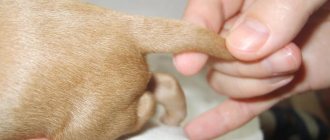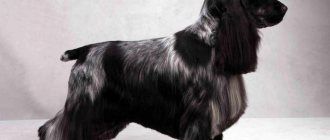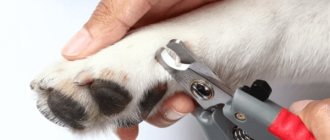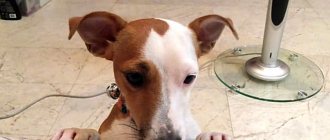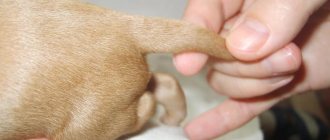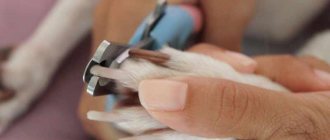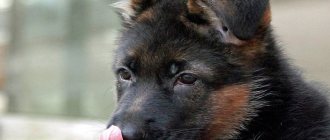Tail docking in dogs is a cosmetic procedure, the purpose of which is to comply with the aesthetic and stylistic traditions that appeared many years ago among some breeds. Many animal protection organizations are actively fighting this phenomenon, considering these methods to be relics of the past coupled with a barbaric attitude towards our smaller brothers.
If previously dogs with cropped ears and tails were commonplace, today this is an operation prohibited in many countries. It is prohibited to enter modern European competitions and exhibitions with animals that have undergone tail or ear docking.
Cupping is perceived negatively by many doctors. The process, despite the safety and experience of the veterinarian, is still very painful for the animal. In some cases, complications cannot be ruled out.
We accept them as they are
Today, more and more often you can see purebred dogs in their natural form on the street. The ears of Dobermans and Great Danes no longer stand on their heads, cut according to patterns in the shape of a flame. Being lop-eared, they do not have such a menacing appearance, but, once you get used to it, you can say that they are even cuter this way. Long tails in some breeds also seem like an extra “detail,” but this is easier to perceive.
For many inexperienced owners, this question is very relevant. When do puppies have their tails docked and is it necessary? Today, docking is officially prohibited for most breeds in the European Union. In Russia, for now you can still trim your ears and tails or leave everything as is. In any case, they will be accepted for breeding and will be allowed to compete at the breeding show. But if you decide to follow traditional standards, then you need to find out when puppies have their tails docked.
Contraindications and prohibition for surgery
Contraindications include any health problems: weakness, loss of appetite, inflammatory reactions, infections. There is also an age limit. After 1 month, animals are not operated on. An official ban on surgical intervention has been adopted in all countries that have signed the European Convention.
When does this happen
If the mating was registered at the club, then after the puppies are born you must invite a specialist who will carry out an examination. He examines the offspring and, if he recognizes them as purebred, then leaves puppy cards. Now you can call the veterinarian. Usually the curator of the breed informs the owner when the puppies have their tails docked. There is not much time to think. Depending on the breed, this is done on days 2-7 of life, while the vertebrae are still very soft.
Examples of docked and undocked dogs of different breeds
Central Asian Shepherd Dog (Alabai)
An example of an undocked dog of the Central Asian Shepherd breed.
An example of a docked dog of the Central Asian Shepherd breed.
Doberman
An example of an undocked Doberman dog.
An example of a docked Doberman dog.
Pit bull terrier
An example of an undocked pit bull terrier dog.
An example of a docked pit bull terrier dog.
Giant Schnauzer
An example of an undocked Giant Schnauzer dog.
An example of a docked Giant Schnauzer dog.
miniature pinscher
An example of an undocked miniature pinscher dog.
An example of a docked miniature pinscher dog.
Is it possible to do this yourself
Highly undesirable unless you are a long-time breeder. The procedure is carried out without anesthesia; at this age it is contraindicated. Moreover, no special equipment is required for this. But you shouldn’t do the operation yourself, unless you are an experienced breeder. But the ears are cropped at the age of two to three months under general anesthesia.
Choosing the age for tail and ear docking
For Caucasian and Central Asian shepherd dogs - the 2nd day from birth (tail and ears).
For Rottweilers, Airedale Terriers, Drathars, Shorthaired Pointers, Pembrokes, Spaniels, Poodles, Mastino Neapoletano, Doberman Pinschers, Boxers, Giant Schnauzers, Miniature Schnauzers - the 2nd day from birth (tail).
For Cane Corso - 45-55 days from birth (tail and ears).
For pit bull terriers, Staffordshire terriers, American bullies, Dogo Canarios, Great Danes, Dogo Argentinos, boxers, Dobermans, Giant Schnauzers, Miniature Schnauzers, Beaucerons - 60-75 days from birth (ears).
For miniature schnauzers and miniature pinschers - 100 days from birth (ears). For these breeds, it is better to have their tail docked at the age of 2 days, but it can be combined with ear docking.
Veterinarian work at home
It is not necessary to have your puppies' tails docked at the clinic. You can call a doctor home and provide him with a comfortable desk for work. The entire operation takes just a few minutes, after which the puppies will be returned to their mother. The doctor will have to lay out sharp scissors, cotton wool, antiseptic, and sterile wipes. Nothing else is needed. There are no stitches on the tail, which significantly speeds up the procedure.
So, usually the puppies are taken away from their mother, and she is sent out for a walk. The owner takes out the first baby and hands it to the doctor. He quickly cuts off the tail and presses the wound with a cotton swab containing a disinfectant solution. After two minutes, the baby goes into the basket, and the veterinarian takes the next one. Puppies with docked tails fall asleep very quickly, as if they were not in pain. Therefore, when the mother returns, she will find her family completely calm.
Attitude to cupping today
The tradition of ear cropping has become so firmly established that over time, standards have been issued for individual breeds for which this procedure has become mandatory. True, in recent years, more and more owners are refusing the operation, considering it inhumane. Following the breeders, the attitude of the jury changes.
In Europe they went further and, starting in the 2000s, introduced a ban on the participation of dogs with cropped and artificially placed ears. The exception is cupping for medical reasons.
Tail length
There are no clear standards here. Some breeds have 2-3 tail vertebrae left, while others, such as Airedales, only have one third of the tail removed. There are breeds that do not have a single standard, that is, the breeder himself decides what to do with the tail. For example, wolfhounds. But all standards agree on the age at which puppies have their tails docked. While the vertebrae are still soft, this operation will be the least painful. Therefore, there is no need to delay. If you decide to trim the tail, do it before your pet reaches ten days of age.
A little history
In the 18th century, residents of England had to pay a dog tax on every four-legged representative, unless he was a service dog, for which tail docking was a mandatory procedure.
The reason for removing the tail of many dogs in those days was to allow hunting dog owners to evade responsibility for poaching. Hunting dogs did not have their tails docked. Shepherds of sheep flocks were exempt from paying the tax. They docked the tails of their assistance dogs to reduce their injury in fights with predatory animals. Therefore, many residents of Foggy Albion, in order to avoid taxes, cut off the tails of their pets, showing that the dog was a representative of the service. Over time, laws changed, the tax was abolished, but bobtail remained a necessary attribute of some breeds.
Cupping provided by the standard
Cropping ears
In this case, a lot depends on the breed. For the Caucasian Shepherd, this is the third day of life. The operation is not too complicated. For puppies, the top of the ear is simply cut off while it is very thin. You get ears like those of a bear. Therefore, it is quite possible to crop a puppy’s ears and tail at the same time.
If we are talking about Dobermans or Great Danes, then everything is more complicated. The owner needs to wait until the babies are three months old. During this time, the head and ear will reach the desired size. Before the procedure, the babies are not fed for eight hours, after which they are taken to the veterinary clinic. There, surgeons are already taking up their work:
- First of all, anesthesia is administered. The puppy is placed on a special table, its paws are extended and firmly secured. In addition, the puppy’s jaw and torso are fixed.
- The auricle is treated with an antiseptic, and the area where docking will be done is cleaned of hair.
- Using a special pattern, doctors cut the desired shape. The operation lasts about an hour, so the owner needs to be patient.
- After the operation, the treatment is repeated and the patient is sent home. The stitches usually need to be removed after two weeks.
At what age is it best to have surgery?
The best age for cupping is 3-10 days after birth. It is believed that during this period puppies are less sensitive to pain, and the cartilaginous joint tissues have not had time to ossify. Therefore, children are operated on without anesthesia, without applying a tourniquet. The main rule is healing without licking the mother; the breeder must monitor this.
Amputation is often performed at the age of 10-20 days . Then local or general anesthesia is required. The dog is placed on its stomach, its paws and muzzle are fixed, and part of the tail is removed. If a dog is operated on at 3-4 weeks, then a tourniquet must be applied to the tail.
Evidence from experts suggests that puppies have an increased sensitivity to pain and the “humaneness” of tail trimming in childhood is not confirmed by anything. During amputation, the integrity of muscles, tendons, bone and cartilage joints is disrupted. In this case, more than 14 sensory nerves are affected.
Before the operation, laboratory tests are carried out: blood tests, ultrasound, and less often, x-rays. This is necessary to exclude contraindications to drugs and anesthesia components. Before the procedure, it is recommended to prepare your pet:
- Cleanse from helminths within 2 weeks;
- Do not feed your pet for 12 hours, but increase the drinking regime;
- Every hour before surgery, measure the temperature (maximum - 39 degrees, minimum - 37);
- Select the amputation site (the breed standard will help with this), shave the tail in the selected area, and disinfect it with an aqueous antiseptic (Chlorhexidine).
A categorical contraindication is congenital physiological abnormalities in the puppy. The procedure is not performed on lethargic, sick pets with unusual or inflamed discharge.
Recovery after surgery
Even if we are talking about tail docking, it is still a surgical intervention. Therefore, the doctor must assess the risks and familiarize the breeder with them. If the puppy is weak, then it is recommended to postpone this procedure and, at an older age, perform it under anesthesia or abandon it altogether.
After tail or ear docking, puppies require the most careful care. The place where they sleep should be dry and clean so that there is no risk of infection. The wound must be examined twice a day. The slightest signs of suppuration are the reason for an immediate visit to the doctor. Such intervention in itself is traumatic for the animal. Therefore, a decrease in appetite may occur and drowsiness may occur during the first two days after the procedure. But if the puppy completely refuses to eat, then you need to sound the alarm.
Cupping – good or bad?
When can a dog's tail be docked? This is a question that has set many dog breeders and scientists on edge. According to research conducted at Cleveland University, where 50 puppies of different breeds were used as “experimental subjects”, the following was established:
- Each of the puppies squealed when their tail was docked;
- After the procedure, the puppies continued to whine for an average of 140 seconds;
- After this time, they calmed down, but still squeaked, feeling discomfort when moving;
- In the process of studying the reaction of dogs, not a single baby died.
What conclusion did the scientists come to? Dogs, like any living creature, even at an early age experience pain and discomfort after surgery. Most researchers have come to the conclusion that this is senseless abuse of animals. It will be interesting about the causes of tooth loss in dogs.
Modern research has shown that the tail is also an organ of communication for dogs - for example, when they are scared, they tuck it, if they are happy, they wag, and when they smell something or feel danger, they pull it out with an arrow. That is why this operation is considered inhumane.
The last question remains - is it possible to dock the tail of an adult dog? Most veterinarians are inclined towards the negative option. Cutting off formed bones, even under anesthesia, will cause terrible pain to the animal. Also, the healing process will be very difficult. And lastly, your pet may be very offended (yes, in this regard they are like people) and simply cannot understand why they were “punished” like that and are experiencing such pain.
Currently reading:
- Ages and breeds of dogs for ear cropping
- Tips for proper dog burial
- The American Cocker Spaniel is an adroit hunter and loyal friend.
- Actions to take in case of an epileptic attack and a shaking dog
Misconceptions and facts
And today, most owners are confident that they are doing this in the interests of their dog. In fact, she is fine the way nature created her. We have already talked about the day on which puppies’ tails are docked. Of course, they will quickly forget the pain, because they are too small. But they won’t get any benefit from a short tail. Let's look at the main misconceptions that justify cupping:
- The procedure reduces the ears' susceptibility to diseases and inflammation. It has already been proven that the shape of the auricle has no effect on this. If you clean your ears on time and consult a doctor if necessary, you will not need to do cupping.
- Many people believe that this procedure is painless. This conclusion is drawn from how quickly puppies calm down. In fact, they are in pain, just like everyone else. And the postoperative period is painful for all living beings. Moreover, anesthesia itself is very harmful to dogs.
- It is believed that the dog will be better off without a tail and ears. A very strange conclusion, because these are the organs that are responsible for communication. Movements of the ears and tail show the mood of the pet, helps to interact with other animals and humans. Therefore, leaving the dog without them and believing that you are doing it better is strange, to say the least.
Is it possible to dock the tail of an adult dog?
The main problem when operating on adult dogs is complications after anesthesia. Not all animals over 2 years of age respond positively to anesthesia. The heart is especially defenseless against the action of anesthetic vapors.
Any dog owner will say that “the game is not worth the candle.” Because of a simple whim, a person can lose a pet. Although veterinarians take on work of any complexity, issuing large checks for the procedure. In any case, it is better not to take risks and leave the pet’s tail in its natural form.
How is cupping done?
It all starts with preparation for surgery. Before the procedure, the dog is put on a diet: the animal must fast for 10-12 hours. You can give water.
During the operation, anesthesia is administered. For puppies, local anesthesia is used, for older dogs - general anesthesia. To prevent bites, put a muzzle on your pet. The owner must be present at the operation in order, firstly, to calm the pet, and secondly, to fix its body. It is necessary to hold it by the front and hind legs so that the animal does not move. Cupping is performed on the operating table.
The veterinarian's actions are as follows. First, the doctor trims the hair on the operated area, after which he treats the skin with an antiseptic solution and applies markings. After this, an incision is made in the direction from the top of the ear to the base along the marking line. At the end of the operation, the cut is sutured and again treated with antiseptics.
Scientific explanation
Docking refers to the surgical removal of part of an animal's tail.
The procedure is carried out solely for aesthetic purposes. With its help, it is possible to create a certain appearance for the animal and maintain breed standards.
Brief historical background
The first mentions of tail cutting can be traced back to Ancient Rome. Then the shepherds were convinced that if the last of the tail vertebrae was docked in puppies, the dog would be protected from rabies for life.
Such manipulations were carried out strictly on the fortieth day from the moment the babies were born.
After a while, they began to resort to this procedure for other reasons. It was performed on guard and hunting dogs to prevent injury. The tail was considered only an appendage. They could have stepped on him and grabbed him. In this way they tried to protect the pet from damage from thorns and foxtail.
A more banal reason was not about caring for dogs, but about money: in the 18th century, a tax was introduced on all dogs in England. The only exceptions were service breeds, for which it was customary to have their tails docked.
Dog breeders who performed this procedure on their animals were exempt from this tax.
The tax law was soon repealed, but tail docking was still practiced for a long time: the procedure was carried out only for the purpose of winning at the exhibition. Only at the end of the 19th century in Great Britain they began to allow dogs to participate in the form in which nature created them.
Prohibition on the procedure
In the 90s of the 20th century, the European organization of dog handlers decided to abandon this operation. She was considered inhumane and useless.
Now it is banned in many countries. Among them:
SOUTH AFRICA;- Australia;
- Iceland;
- Switzerland;
- Norway;
- Israel.
In the UK, docking is also prohibited. But in special situations the procedure is acceptable.
When is the procedure allowed?
Docking is carried out if the dog is in service or performs the following functions:
- in the armed forces;
- in law enforcement agencies;
- destroys rodents;
- in the emergency rescue service.
Important tip
Some dog breeders do docking for their dog themselves. This should not be done, since this is an operation that requires strict sterility and compliance with certain rules for this procedure. According to statistics, most often suppuration of the circumcised area occurs due to non-compliance with all sterility rules during cupping. Remember that it is better to keep the dog's entire tail than to end up with a pet with an ugly, crooked stump. Whether or not to carry out such a procedure is a subjective decision.
Description of methods for docking puppies
- If surgery occurs under general anesthesia, then inhalation ether anesthesia, which contains a vagolytic, is used. It prevents salivation and normalizes heart function. Also, dogs that have a short muzzle structure undergo procedures to prevent tongue retraction. How many millimeters of the tail is trimmed depends on what breed the dog is. First, the hair is shaved off the tail, the skin is stretched to the maximum towards the body, and a small part of the tail is directly amputated using a surgical scalpel or special scissors. An incision is made in the space between the vertebrae. The skin is returned to its place and sutured. The wound must be treated with a prescribed antibiotic, and antiseptics are applied to the skin around the wound. Next, a sterile bandage must be applied to the wound.
- This docking method involves pinching the tail with an elastic band for some time. Usually this is from two days to a week. The point is that with this method, no blood flows into the tip of the dog’s tail and, after some time, it simply dies and falls off. This method is considered one of the most humane, but it is difficult to agree with this, because no one can know exactly how the animal feels during these seven days.
There is a claim that puppies do not feel pain because of their imperfect nervous system, but all kinds of studies refute this fact . After surgery, the puppy whines for a long time and cannot calm down. And the older the individual, the more difficult it is for her to endure this operation. Breeders must make a responsible decision and understand whether it is really worth putting their beloved pet through suffering.
The postoperative wound takes a long time to heal . And the entire period from the day of surgery until complete healing, the wound must be treated daily to prevent infection. When docking is performed in a specialized veterinary clinic, there are rarely cases of complications. Usually everything goes pretty smoothly.
Scientists' opinions on the procedure
Scientists have not yet come to a consensus on cutting the tail of dogs.
Many veterinarians criticize this procedure, considering this part of the body to be vital from an anatomical point of view. As a result of its removal, motor skills are impaired and urinary incontinence develops.
Among scientists there are those who are not so categorical. They believe that tail removal is acceptable to prevent injury.
Expert opinion
Makarenko Svetlana Igorevna
Practicing veterinarian, 15 years of experience.
True, in this case it is necessary to provide convincing evidence and justify the risks, for example, breed predisposition, birth defects or the further use of the animal.
